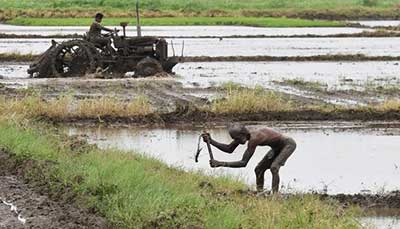Relevance: GS-2: Government policies and interventions for development in various sectors and issues arising out of their design and implementation;
Relevance: GS-3: Indian Economy and issues relating to planning, mobilization of resources, growth, development and employment; Inclusive growth and issues arising from it;
Key Phrases: Credit Flow, Priority Sector lending, Warehouse receipts, adjusted net bank credit, Agriculture Infrastructure Development Fund, ESG (environmental, social and governance) principles.
Why in News?
- Timely and adequate availability of finance is necessary for sustained growth in production and trade volumes. However, credit alone isn’t sufficient. There’s a need to step up funding of farm research and introduce ESG (environmental, social and governance) principles.
Key Points:
- Finance or credit is a critical input for production and trade.
There is a positive correlation between credit flow on the one hand and
production and/or export on the other.
- While correlation exists, it is as yet unclear if credit is actually a causative factor for changes in production/trade.
- Hence, more research is needed to demonstrate if changes in credit flow cause changes in production/export.
-
Structured financing and warehouse receipts are two examples of tailor-made ways of financing production/export.
-
Structured financing is transaction-based lending which ensures better quality of asset for the lenders even as it substantially reduces the risk associated with lending. It also helps traceability of goods or trade financed even as it helps eliminate over-trading.
-
Warehouse receipt financing works on the basis of goods brought into an accredited warehouse for which the warehouse-keeper issues a receipt of storage, indicating quantity, quality and other parameters.
-
The receipt can then be pledged, either fully or partially, with a commercial bank and money can be borrowed.
-
- In our country, traditional methods of financing have by and large
delivered, and will continue to play a role; but it also needs to
recognise that they are inefficient systemically.
- So, both borrowers and lenders explore newer methods of finance customised to suit their specific needs.
Priority Sector means those sectors which the Government of India and Reserve Bank of India consider as important for the development of the basic needs of the country and are to be given priority over other sectors.
- The banks are mandated to encourage the growth of such sectors with adequate and timely credit.
- Banks lend nearly 40% of their adjusted net bank credit (ANBC), to the priority sector.
- The categories of priority sector are Agriculture, Micro, Small
and Medium Enterprises, Export Credit, Education, Housing, Social
Infrastructure, Renewable Energy and Others.
- The biggest is agriculture with an 18% target of total ANBC.
- India’s priority sector lending policy has the right intention of
supporting the sections that are critical for the economy but are generally
vulnerable and deserve support.
- Such sections include farmers, exporters and micro, small and medium enterprises.
- Considering the size of the economy as also the widely varying size and number of borrowers, one can say that our priority sector lending policy is appropriate for our socioeconomic status.
- However, it is an entirely different question whether such lending has
achieved its objectives in full.
- Moreover, higher allocation of credit alone is most unlikely to lift the fortunes of players in the priority sector.
- It must be conceded that credit is a necessary condition, but not a sufficient condition.
- So, we need to go beyond priority sector lending.
OECD Experience
- Priority sector lending is known as directed credit programme in developed countries.
- The OECD countries spend as much as $500 billion annually on
‘farm support’, a euphemism for subsidy.
- Of this, $80-90 billion is spent on what is described as ‘general services’ which cover farm research and development, agri infrastructure and innovation systems, quality inspection, control and certification, market development, bio-security, and so on. The expenditure is crop neutral.
- Similarly, the US continues to implement Export Credit Guarantee
Programme (GSM-102) related to export credit guarantees by the US
Department of Agriculture.
- The programme aims to encourage commercial export financing of agricultural commodities from the US by providing credit guarantees.
- Indeed, policymakers must seek to reduce the economy’s over-dependence,
if any, on credit given the various challenges like costs, operational
inefficiencies, and risk of unintended exclusion/inclusion of borrowers.
- It is demonstrated by many studies that small farmers are left out.
- Many are forced to continue to depend on moneylenders and the like for credit needs.
- Also, there are regional disparities in the requirement and disbursal of credit.
Way Forward:
- It is necessary for us to learn from the experience of developed
countries and step up such expenditure as given above.
- It will help reduce the vulnerability of growers and other value chain participants to supply chain inefficiencies and market shocks.
- The government has no doubt created the Agriculture Infrastructure Development Fund (AIDF), but the nation needs to get a report card of its progress.
- There’s need for the introduction of ESG (environmental, social and
governance) principles in India’s priority sector lending programme,
especially for farm exports.
- India export several million tonnes of rice and sugar every year, often subsidised. Rice and sugar are water guzzlers.
- Amid acute water scarcity in the country, export of rice and sugar would mean indirect export of water.
- Lending institutions must demonstrate a moral duty towards the society and environment protection.
Source: The Hindu BL
Mains Question:
Q. The rationale of priority sector lending deserves a review. Analyse critically.









